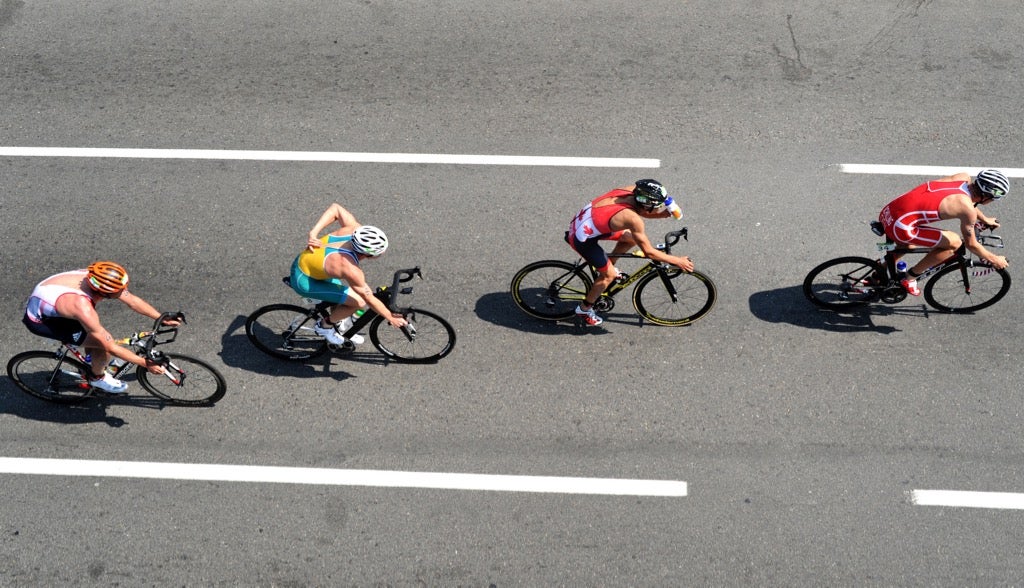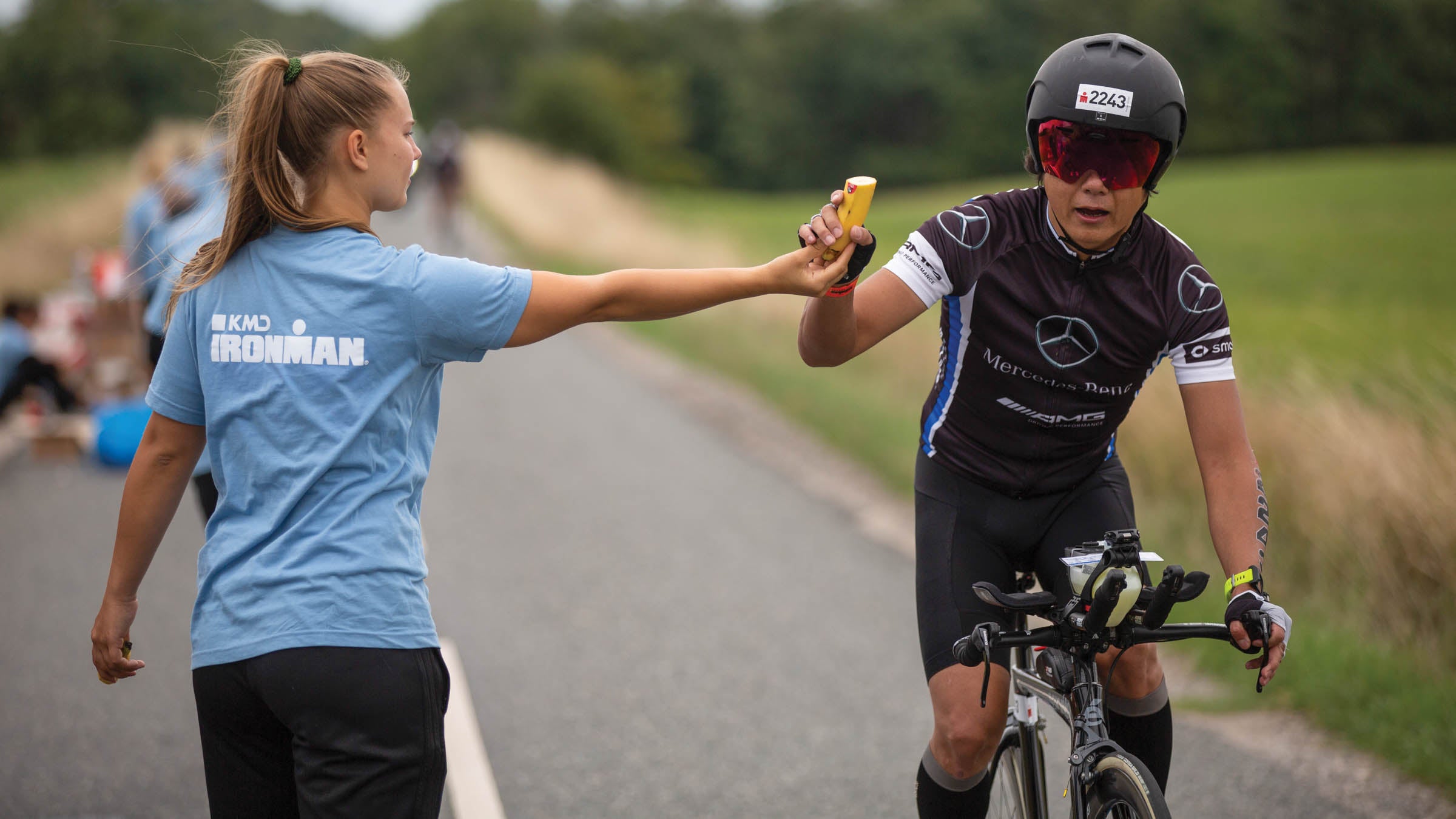New perk! Get after it with local recommendations just for you. Discover nearby events, routes out your door, and hidden gems when you sign up for the Local Running Drop.
Nutrition is often referred to as the fourth discipline of triathlon—and it’s for good reason. Knowing what to eat and when as you train, prepare, and race triathlon can sometimes seem overwhelming, especially when you’re first starting out. It can be challenging enough to string together swim, bike, and run, much less formulate a sprint or half-Ironman nutrition plan. Fortunately, we’ve pulled together all you need to know on the triathlete diet, making a triathlon nutrition plan, and even meal planning for triathletes. And to be clear from the outset: When we refer to nutrition or diet, we are typically referring to food eaten outside of training or racing. When we talk about fueling, that’s calories and/or hydration consumed during training and racing.
What to eat when training for a triathlon
Every triathlete’s diet should contain carbohydrates, proteins, and fats, with a good amount of fruits and vegetables to help optimize calorie and nutrient intake. A good meal plan for triathletes ensures you eat enough so that your workouts are well-fueled and your body can recover and adapt ready for the next workout.
RELATED: 7 Day Triathlon Meal Plan
When it comes to protein and the triathlete diet, you should be taking on 1.4–1.6 grams of protein per kilogram of body weight per day (roughly 100–115 grams for a 160-pound athlete, or 75–85 grams for a 120-pound athlete). As you progress in the sport, you may find you need to dial in your protein intake as it supports muscle recovery and immune function. When doing higher-volume blocks of training and higher-intensity workouts, it’s important to always take on 20-30 grams of protein within 20-30 minutes of finishing your workout to help refuel your glycogen stores, bring down cortisol (the stress hormone that is elevated during harder exercise), and kickstart the recovery process.
The triathlete diet should also contain a lot of carbohydrates to support training and recovery. Your carb needs can easily increase from 5 grams per kilogram of bodyweight per day to 8-plus grams when training jumps from an hour to two or more hours a day (a jump from 350 to 580 grams of carbs per day for a 160-pound athlete, and from 275 to 430 grams of carbs per day for a 120-pound athlete). But not all carbs are created equal—as an athlete, you’ll want to seek out high-quality sources of carbohydrates.
Fat intake should increase to keep up with your jump in calorie needs, to provide anti-inflammatory benefits to counteract the effects of high training volume. The triathlete’s diet should see your total fat intake be 20-30% of your total calories. After you’ve found your perfect balance of the above macronutrients, you can then turn your focus on more detailed micronutrients like Iron and vitamin D.
RELATED: What is the Right Balance of Carbs, Fat, and Protein?
This table summarizes what the above looks like for two sample triathletes, one weighing 120 lbs., the other weighing 160 lbs.:
| Weight | Protein | Carbs | Fat |
| 120 lbs. | 75-85g | 275-430g | 65-80g |
| 160 lbs | 100-115g | 350-580g | 80-100g |
Note: If you want exact calculations based on your individual metabolic rate, training volume and weight goals, seek the advice of a board-certified sports dietitian (C.S.S.D.) who can review your training and food log and create a specific triathlon meal plan for you.
RELATED: 9 Nutrition Rules for Beginner Triathletes

What to eat for triathlon training: Swim
Using a triathlon meal plan is a popular option for athletes—largely because balancing training with work, life, family, and still managing to eat well can be a tricky process. As many athletes tend to swim early before work, it’s quite common for triathletes to have a light “first” breakfast (e.g., a slice of toast with peanut butter) and then have a proper refuel post-swim with a “second” breakfast that has adequate amounts of protein, carbs, and good fats (think: omelette with veggies and toast or oatmeal/muesli with yogurt and fruit). If it’s a longer session, you might want to consider having some water or electrolyte drink on the pool deck. Don’t forget that you do sweat while you swim!
If you are someone who rushes from an early-morning swim straight into your work day, then it’s here that you can really stand to benefit from meal planning.
RELATED: Ask Stacy: How Should I Fuel Before an Early-Morning Workout?
Section dividerWhat to eat for triathlon training: Bike
For shorter rides of 90 minutes or less, it’s unlikely you’ll need to take on much (unless you’re bouncing from another workout or haven’t eaten a meal for several hours beforehand). Always carry water or electrolyte drink and aim to drink about 16 ounces per hour (but this can vary greatly depending on your hydration needs, so be sure to experiment with what works best for you). For longer rides of 90 minutes or more, you’ll likely want to take on calories as well as hydration, and the choices are endless. If you’re new to the sport, ask fellow athletes for their tips and recommendations on their preferred options. Remember that it doesn’t necessarily need to be fancy energy bars or energy chews (although they certainly have their place)—you can fuel perfectly well with many “real food” options, such as bananas, nuts, or home-made bars.
On the bike when doing longer rides, sports nutritionist Dr. Stacy Sims recommends aiming for 1.5 to 2 calories per pound of bodyweight per hour, and it’s important to go for mixed macronutrients (carbs, protein, fats) to keep energy levels even and allow less full glycogen depletion to occur. She said: “Remember that small bites of food frequently are better than huge calorie intakes all at once. Good examples include: small salted potatoes, white bread peanut butter and jelly sandwiches, and energy balls.”
Section dividerWhat to eat for triathlon training: Run
Most triathletes agree that eating while running can be a tricky business, and unless you’re covering mega miles, you won’t need to take on calories while you’re running—simply fuel and hydrate well beforehand and refuel adequately afterwards. The best diet for triathletes is often one that isn’t too high in fiber before big run workouts (and race day), to lower the chance of G.I. (gastrointestinal distress). Runners’ trots is an all-too-common phenomenon among endurance athletes (and they love talking about it!).
If you do want to fuel during a run workout, the best options are typically fluids (electrolyte drinks or energy drinks) or energy chews or gels. Keeping your blood sugar up and minimizing any digestion issues is usually the top priority. If you’re looking to take on more and carry more (for runs of two hours or more, for example), you could consider wearing a hydration vest. Remember that longer and hotter workouts will require you to replace what you’re sweating out. Though water alone is fine for shorter sessions, you’ll want to up your sodium intake for training and racing lasting more than one hour.
RELATED: How Much Salt Do You Need for Training and Racing?
Section divider
The triathlete’s diet: Eating for recovery
Any good triathlon training diet will always feature plentiful protein and carbs, not just to help you fuel, but equally as importantly, to help you refuel. The recovery process can really only get under way when you are giving your body the nutrients it needs to adapt, rebuild, repair, and prepare for whatever you have lined up next. Consuming 20-30 grams of protein in the 20-30 minutes after finishing your workout (particularly long or harder workouts) can help your body to repair faster, stimulating protein synthesis in the muscles. Good examples of high-protein refueling foods might include: eggs, yogurt, kefir, cottage cheese, and protein shakes.
RELATED: Ask Stacy: Which is Better, Whey or Plant Protein?
Of course, you need more than just protein: Carbs are important for refueling too and will help replenish glycogen stores. Good examples of post-exercise carbs can include sweet potatoes, quinoa (or any grains), fruit and veggies. Pairing proteins with carbs post-exercise is ideal and some athletes prefer to take on a lighter, high-protein snack within their refueling window and then eat a more substantial carb and protein meal within 90 minutes of finishing their workout.
This article on How to Eat for Recovery gives a lot of tips on how to eat to prevent illness, recover from illness, prevent injury, and recovery from injury. If you’re looking for an anti-inflammatory meal plan, start here.
Ensuring you eat enough, especially after training, can go a long way to keeping you fit, well, and healthy. It is far too easy for triathletes to prioritize weight goals or body composition targets at the expense of adequate fueling and refueling. This can lead to the Relative Energy Deficit in Sports (RED-S), which can diminish performance, affect immunity along with menstrual function for women and bone health, and be tied to overtraining syndrome since the body cannot recover. It can also lead to longer-term health problems.
Coach Matt Fitzgerald, author of Racing Weight, has written extensively on this topic, including this recent piece on “The Great Race Weight Debate”, which features three key pieces of advice that all triathletes, regardless of their experience level or aspirations, should heed. There’s also this article—”The Do’s and Don’ts of Getting Leaner”—that gives tips on balancing training and weight loss in a safe, smart way.
Section dividerWhat to eat pre-race
Whether you are eating for Ironman or eating for your first sprint race, one of the golden rules is always: Don’t do anything new on race day—and that definitely includes pre-race. An important part of the triathlon training diet is figuring out (in training) what works for you, so come race day (and race eve) you can tuck into your pre-race meal knowing it will deliver you all the calories and goodness you need without any risk of upset stomachs (or worse!). Many triathletes tend to stick with one tried-and-true pre-race meal the night before they race, which is often something simple such as a sweet potato or rice with a simple protein. Others swear by pizza or steak—so it really is as unique as you are. Most people tend to avoid high-fiber and/or high-fat foods to help with optimal functioning of the digestive system.
RELATED: The Expert-Curated, Triathlete-Approved Race Week Menu
On race morning (assuming you are racing early in the morning, as is typically the case with triathlon) your pre-event meal should ideally be consumed 1.5 to two hours before the start of the race.
For shorter races, it isn’t essential to have large amounts of food, but it is important to eat enough to top up liver glycogen stores and prevent hunger. A small breakfast such as toast, instant oatmeal, or a smoothie is ideal. A small carbohydrate-rich snack (e.g., half of a bagel with butter and jam or half of an energy bar) can then be consumed in the 30 minutes before the race if needed.
For longer races (70.3 and Ironman distances), you do not need to set your alarm for a 3 a.m. breakfast—you are looking to top up glycogen stores, prevent hunger, and have some reserves to start the race. You can do this in the same 1.5 to two-hour window, and nutritionists such as Dr. Stacy Sims often recommend toast with jam and instant oatmeal mixed with milk or a milk alternative as a liquid meal. Given that most athletes have pre-race nerves, the easier your meal is to consume and digest the better chance you stand of getting it down.
RELATED: Ask Stacy: What Makes a Good Pre-Race Meal?
Section divider
What to eat during a triathlon race
Many a triathlete will tell you that what you eat during your race can have an epic impact on how well your day goes. Get it right and you’ll likely have a magic day, you might even PR. Get it wrong and you can find yourself feeling bloated and heavy – or worse, in the port-o-potties wondering what on earth just happened. Of course, what you eat during your race will vary depending on the distance you’re covering. We have this at-a-glance guide to race-day nutrition from Dr. Stacy Sims that covers sprint, Olympic-distance, 70.3, and full-distance racing. Note: These guidelines below assume you have fueled well pre-race (so make sure you do!).
What to eat for a sprint distance triathlon:
For races up to an hour in duration, your focus should be hydration, taking small sips throughout the race. If you feel low on energy on the run, you can use a few glucose tablets or energy chews to boost your blood sugar. If you’re racing for closer to 90 minutes, hydration is still a focus (aim for 0.1 to 0.15 fluid ounces per pound of body weight), but look to top up with carbohydrate for the last half of the race. It’s not about how many calories or grams of carbohydrate per hour, but rather about boosting blood glucose. Aim for one to two energy chews every 15 minutes.
RELATED: How To Fuel For Your First Triathlon
What to eat for an Olympic distance triathlon:
Once out of the swim, focus on hydration with small sips of drink, and then aim to eat 200-300 calories of food per hour. Good options include: energy chews, stroopwafels, or small bites of energy bars. Stay focused on hydration, aiming for 0.1 to 0.15 fluid ounces per pound of body weight. Whatever you opt for, make sure it’s easy to digest and won’t lead to blood sugar swings. On the run, it’s about keeping blood sugar up to maintain pace and prevent dips in energy. Energy chews, soft candies, cola, and glucose tablets are all good options here.
RELATED: Nutrition Guidelines for Your First Olympic Triathlon
What to eat for a 70.3 or half-iron triathlon:
When it comes to fluid needs, a half-Ironman nutrition plan (or 70.3 nutrition plan) should follow the same guidelines as outlined above for sprint and Olympic: 0.1 to 0.15 ounces per pound of body weight per hour of racing. Drink to thirst for the first two hours, and then set an alarm to remind yourself to stay on schedule with fluid intake. As you fatigue, it can become easy to lose track and/or lose focus.
On the bike, your calorie intake should be between 1.4 to 1.8 calories per pound of body weight per hour. If this seems like a lot, remember that you are “front-loading” calories to ensure you have reserves for the run too. As an example, a 130-pound athlete should be looking to consume ~180 to 230 calories per hour.
On the run, it’s harder to get in as many calories but your goal calorie intake should still be between 1 to 1.5 calories per pound of body weight per hour. The goal here is different than the bike—it’s simply to keep blood sugar up and minimize digestion issues, which is where energy chews, soft gummy candies, and jelly beans all come into play. Cola and glucose tablets can work well in the last 40 minutes.
RELATED: Ask Stacy: How Do I Fuel for Longer Distances?
What to eat for an Ironman or full iron triathlon:
Once out of the swim and through T1, let your body settle into a rhythm on the bike before trying to take on calories, but be sure to take small sips of fluid. For the first half of the bike, take on 0.1 to 0.15 fluid ounces of electrolyte drink per pound of bodyweight per hour. Once feeling settled, the goal for fueling is 1.5 to 2 calories per pound of bodyweight per hour, and it’s important to go for mixed macronutrients to keep energy levels even and allow less full glycogen depletion to occur. Remember that small bites of food frequently are better than huge calorie intakes all at once. Good examples include: small salted potatoes, white bread peanut butter and jelly sandwiches, and energy balls (but be sure to practice eating these things in training first to make sure they work for you).
On the second half of the bike, aim to keep it similar if you can, but it’s not uncommon to feel like you can’t stomach solid foods. If this happens, stay focused on hydration, and move to energy chews or even candy, but try to avoid that until the last hour. Wait for your stomach to settle and resume food calories if/when you can.
On the first half of the Ironman run, aim for 1 to 1.5 calories per pound of bodyweight per hour—small bites of energy bars or salted chunks of cooked sweet potato are good options. Aid stations often offer pretzels or potato chips, as well as energy bars and chews, so small quantities of these are good if you can stomach them (only if you’ve practiced this in training). The goal, though, is to keep blood sugar up and minimize digestion issues. Keep consuming electrolyte drink—ideally from a bottle you carry with you from T2. Obviously this isn’t possible throughout the entire marathon, but you can adapt by using on-course electrolyte drink diluted with water.
As the race goes on, it’ll likely get harder and harder to keep eating and drinking. Move to energy chews or jelly beans for the last six to eight miles of the marathon (and Coke too) and also remember that glucose tablets are a great go-to—take them on every five to seven minutes.
Staying on top of your fueling, especially in a full-distance race, can be one of the hardest parts of racing for this duration. We can’t emphasize enough how important it is to practice and hone your fueling plan in training (especially with key workouts of similar intensity to race-pace) so you set yourself up for swim, bike, run, and fueling success come race day.
Eat, drink, and race well
The two words that best sum up the triathlete’s diet is “premium fuel.” If your body is an engine, you want to put the very best fuel in it for the very best performance. As the saying goes, “You can’t out-train a bad diet.” An emphasis on a high-quality diet before, during, and after training and racing will help you to perform at your very best.
